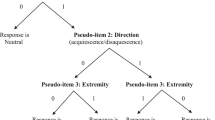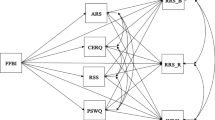Abstract
This study investigated whether dichotomous thinking is characteristic of borderline personality disorder (BPD). Patients with BPD (N = 16), control patients with Cluster-C personality disorder (PD; N = 12), and normal controls (N = 15) evaluated personalities from film clips in a structured response format. Film clips were presented with emotional themes, which were hypothesized to be either specific or nonspecific for borderline pathology, and with neutral themes. Dichotomous thinking was operationalized as the extremity of evaluations on a list of visual analogue scales (VASs) with bipolar trait descriptions. Patients with BPD made more extreme evaluations (dichotomous thinking) on BPD-specific film clips, but not on control film clips, than subjects of both control groups. The extreme evaluations of patients with BPD were not either “all good” or “all bad,” which indicates that patients with BPD do not engage in unidimensional good–bad thinking (splitting), but are capable of viewing others in mixed, although extreme, terms (multidimensional dichotomous thinking).
Similar content being viewed by others
REFERENCES
American Psychiatric Association (APA). (1987). Diagnostic and statistical manual of mental disorders (3rd ed., Rev.). Washington, DC: Author.
Arntz, A. (1994). Treatment of borderline personality disorder: A challenge for cognitive-behavioural therapy. Behaviour Research and Therapy, 32, 419-430.
Arntz, A. (1999). Do personality disorders exist? On the validity of the concept and its cognitive-behavioural formulation and treatment. Behaviour Research and Therapy, 37, Supplement 1, S-97-S-134.
Arntz, A., van Beijsterveldt, B., Hoekstra, R., Hofman, A., Eussen, M., & Sallaerts, S. (1992). The interrater reliability of the Structured Clinical Interview for DSM-III-R personality disorders. Acta Psychiatrica Scandinavica, 85, 394-400.
Arntz, A., Bögels, S., & Hoekstra, R. (1992). Revisie van de Nederlandse vertaling van het Gestructureerd Klinisch Interview voor DSM-III-R (SCID-I) [Revision of the Dutch translation of the Structured Clinical Interview for DSM-III-R (SCID-I)]. Maastricht, The Netherlands: Author.
Arntz, A., Dietzel, R., & Dreessen, L. (1999). Assumptions in borderline personality disorder: Specificity, stability and relationship with etiological factors. Behaviour Research and Therapy, 37, 545-557.
Baker, L., Silk, K. R., Westen, D., Nigg, J. T., & Lohr, N. E. (1992). Malevolence, splitting, and parental ratings by borderlines. Journal of Nervous and Mental Disease, 180, 258-264.
Beck, A. T., Freeman, A., & Associates (Eds.). (1990). Cognitive therapy of personality disorders. New York: Guilford Press.
Blatt, S. J., Brenneis, C. B., & Schimek, J. G. (1976). Normal development and psychopathological impairment of the concept of the object on the Rorschach. Journal of Abnormal Psychology, 85, 364-373.
Dreessen, L., & Arntz, A. (1998). Short-interval test-retest interrater reliability of the Structured Clinical Interview for DSM-III-R personality disorders (SCID-II) in outpatients. Journal of Personality Disorders, 12, 138-148.
Fischer, K. W. (1980). A theory of cognitive development: The control and construction of hierarchies of skills. Psychological Review, 87, 477-531.
Harter, S. (1977). A cognitive-developmental approach to children's expression of conflicting feelings and a technique to facilitate such expression in play therapy. Journal of Consulting and Clinical Psychology, 45, 417-432.
Harter, S. (1986). Cognitive-developmental processes in the integration of concepts about emotions and the self. Social Cognition, 2, 119-151.
Harter, S., & Buddin, B. J. (1987). Children's understanding of the simultaneity of two emotions: A five-stage development acquisition sequence. Developmental Psychology, 23, 388-399.
Kernberg, O. (1966). Structural derivatives of object relationships. International Journal of Psychoanalysis, 47, 236-253.
Kernberg, O. (1967). Borderline personality organization. Journal of the American Psychoanalytic Association, 15, 641-685.
Kernberg, O. F. (1976). Object relations theory and clinical psycho-analysis. New York: Jason Aronson.
Kernberg, O. F., Selzer, M. A., Koenigsberg, H. W., Carr, A. C., & Appelbaum, A. H. (1989). Psychodynamic psychotherapy of borderline patients. New York: Basic Books.
Koster van Groos, G. A. S. (1985). Nederlandse vertaling van het Gestructureerd Klinisch Interview voor DSM-III-R (SCID-I) [Dutch translation of the Structured Clinical Interview for DSM-III-R (SCID-I)]. Unpublished manuscript.
Layden, M. A., Newman, C. F., Freeman, A., & Byers Morse, S. (1993). Cognitive therapy of borderline personality disorder. Boston: Allyn & Bacon.
Lerner, H. D., & St. Peter, S. (1984). Patterns of object relations in neurotic, borderline and schizophrenic patients. Psychiatry, 47, 77-92.
Nigg, J. T., Lohr, N. E., Westen, D., Gold, L. J., & Silk, K. R. (1992). Malevolent object representations in borderline personality disorder and major depression. Journal of Abnormal Psychology, 101, 61-67.
Piaget, J. (1952). The origins of intelligence in children. New York: International University Press.
Psychiatrisch Centrum Bloemendaal. (1991). Nederlandse vertaling van het Gestructureerd Klinisch Interview voor DSM-III-R persoonlijkheidsstoornissen [Dutch translation of the Structured Clinical Interview for DSM-III-R personality disorders]. Bloemendaal, The Netherlands: Author.
Segal, H. G., Westen, D., Lohr, N. E., Silk, K. R. (1993). Clinical assessment of object relations and social cognition using stories told to the picture arrangement subtest of the WAIS-R. Journal of Personality Assessment, 61, 58-80.
Segal, H. G., Westen, D., Lohr, N. E., Silk, K. R., & Cohen, R. (1992). Assessing object relations and social cognition in borderline personality disorders from stories told to the picture arrangement subtest of the WAIS-R. Journal of Personality Disorders, 6, 458-470.
SPSS Inc. (1997). SPSS Advanced Statistics 7.5. Chicago: Author.
Stuart, J., Westen, D., Lohr, N., Silk, K., Becker, S., Vorus, N., & Benjamin, J. (1990). Object relations in borderlines, major depressives, and normals: Analysis of Rorschach human figure responses. Journal of Personality Assessment, 55, 296-314.
Weaver, T. L., & Clum, G. A. (1993). Early family environments and traumatic experiences associated with borderline personality disorder. Journal of Consulting and Clinical Psychology, 61, 1068-1075.
Westen, D. (1990). Towards a revised theory of borderline object relations: Contributions of empirical research. International Journal of Psycho-Analysis, 71, 661-693.
Westen, D. (1991a). Clinical assessment of object relations using the TAT. Journal of Personality Assessment, 56, 56-74.
Westen, D. (1991b). Social cognition and object relations. Psychological Bulletin, 109, 429-455.
Westen, D., Lohr, N., Silk, K. R., Gold, L., & Kerber, K. (1990). Object relations and social cognition in borderlines, major depressives, and normals: A Thematic Apperception Test analysis. Psychological Assessment: A Journal of Consulting and Clinical Psychology, 2, 355-364.
Westen, D., Ludolph, P., Block, M. J., Wixom, J., & Wiss, F. C. (1990). Developmental history and object relations in psychiatrically disturbed adolescent girls. American Journal of Psychiatry, 147, 1061-1068.
Westen, D., Ludolph, P., Lerner, H., Ruffins, S., & Wiss, F. C. (1990). Object relations in borderline adolescents. Journal of the American Academy of Child and Adolescent Psychiatry, 29, 338-384.
Westen, D., Ludolph, P., Silk, K., Kellam, A., Gold, L., & Lohr, N. E. (1990). Object relations in borderline adolescents and adults: Developmental differences. Adolescent Psychiatry, 17, 360-384.
Whitesell, N. R., & Harter, S. (1989). Children's reports of conflict between simultaneous opposite-valence emotions. Child Development, 60, 673-682.
Author information
Authors and Affiliations
Rights and permissions
About this article
Cite this article
Veen, G., Arntz, A. Multidimensional Dichotomous Thinking Characterizes Borderline Personality Disorder. Cognitive Therapy and Research 24, 23–45 (2000). https://doi.org/10.1023/A:1005498824175
Issue Date:
DOI: https://doi.org/10.1023/A:1005498824175




